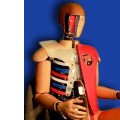On August 17, 1896, Bridget Driscoll became the first victim of an automobile, when she was struck down and killed in front of London's Crystal Palace. Three years later, on September 13, 1899, Henry Bliss entered the history books as North America's first motor vehicle fatality when he was hit stepping off a New York City trolley. Since that time, in excess of 20 million people worldwide have lost their lives to motor vehicle accidents.
The need for a means of analysing and mitigating the effects of motor vehicle accidents on human bodies was felt very soon after the commercial production of automobiles began in the late 1890s, and by the 1930s, with the automobile a common part of daily life, the number of motor vehicle deaths was becoming a serious issue. Death rates had surpassed 15.6 fatalities per 100 million vehicle miles and were continuing to climb; vehicle designers saw this as a clear indication it was time to do some research on ways to make their products safer.
In 1930, the interior of a car was not a safe place even in a low-speed collision. Dashboards were made of rigid metal, steering columns were non-collapsible, and protruding knobs, buttons, and levers were ubiquitous. Seat belts were unheard-of, and in a frontal collision, passengers hurled through the windshield stood very little chance of avoiding serious injury or death. The vehicle body itself was rigid, and impact forces were transmitted directly to the vehicle occupants. As late as the 1950s, car manufacturers were on public record as saying vehicle accidents simply could not be made survivable; the forces in a crash were too great and the human body too frail.
Crash test dummies are full-scale replicas of human beings, weighted and articulated to simulate the behavior of a human body in a vehicle mishap, and instrumented to record as much data as possible on variables such as speed of impact, crushing force, bending, folding, or torquing of the body, and deceleration rates during a collision. In modern times, they remain indispensable in the development of new makes and models of all types of vehicles, from family sedans to fighter aircraft.

